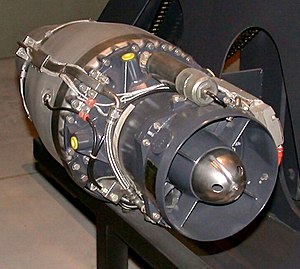Teledyne CAE J402
| J402 | |
|---|---|
 |
|
| Teledyne CAE J402-CA-400 | |
| Type | Turbojet |
| National origin | United States |
| Manufacturer | Teledyne CAE |
| First run | August 1974 (first qualified) |
| Major applications |
Harpoon MQM-107 Streaker |
| Developed from | Teledyne CAE J69 |
The Teledyne CAE J402 is a small turbojet engine designed to power unmanned air vehicles such as missiles and target drones. Developed in the 1970s for the Harpoon anti-ship missile, the J402 was the first jet engine to be designed as a "wooden round", meaning that the engine had to be able to sit for long periods without maintenance or inspection and work right away. Several variants of the engine have been developed, some of which power unmanned aerial target drones.
The J402 engine was designed for the Harpoon missile from the beginning. Its size and weight were dictated by the already-planned missile (just over 12 inches (30 cm) in diameter, about 100 lb (45 kg) in weight). The engine also had to be designed to be inexpensive; the military wanted to produce and store large quantities of the missile. To meet these requirements, Teledyne aerodynamically scaled their J69-T-406 turbojet to just 32% air capacity. This brought thrust and size down to the desired levels.
The J402-CA-400, the original Harpoon variant, was qualified in 1974 and proved to be extremely reliable, failing only twice in 131 flights through mid 1980. The J402-powered Harpoon had an excellent service record, including sinking two Libyan warships during the 1986 Gulf of Sidra Incident. Through 1988, the oldest J402 engine fired in a Harpoon was over eleven years old, exceeding the original five year "wooden round" requirement.
The J402-CA-400 was a single-shaft engine, with one axial compressor stage and one centrifugal compressor stage. The compressed air was combusted in an annular combustor, and then passed through a single high-pressure turbine stage before being exhausted. Because the engine was designed for a one-time use missile, its service life was only one hour. The primary challenge of the "wooden round" requirement was to design the engine to be as reliable as possible. To that end, significant efforts were made to reduce the number of individual parts throughout the engine. For example, the rotor system of the J402 had 16 parts, while the J69 (the parent engine) had 149 parts for the same system. Another simplifying measure was to eliminate the standard gearbox. All the engine accessories, like the fuel pump and electrical alternator, ran directly off the rotor shaft. Engine starting was another reliability-critical function of the engine, and to accomplish that requirement, the J402 utilizes pyrotechnic cartridges to start the engine. Finally, the engine was among the first to feature a fully electronic analog fuel controller.
...
Wikipedia
